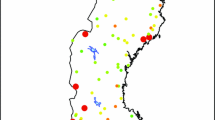Abstract
Although SO2 emissions and deposition rates havedeclined substantially since the implementation of sulphuremission control programmes in North America [1], recovery(measured as decreases in \({\text{SO}}_{\text{4}}^{{\text{2 - }}} \) concentrations) of affected lakes in central Ontario has been much less substantial thananticipated based on the decrease in deposition. The slowrecovery is attributed to the reoxidation and release of storedsulphur in catchments. Reduced sulphur retained in previousyears when sulphur deposition was higher is exposed to air andoxidized during severe droughts, then exported duringsubsequent wet periods. Elevated stream \({\text{SO}}_{\text{4}}^{{\text{2 - }}} \)concentrations and export rates occur in the autumns of yearswith prolonged severe droughts, particularly in catchments withextensive wetlands. Drought in our study catchments occurred inyears following strong El Niño events. When the SouthernOscillation Index (SOI) was strongly negative (1976–77, 1982–83,1986–87, 1991–92, 1993–94) the frequency of occurrence ofdrought the following summer in small catchments with shallowoverburden was extremely high. A lake‘s rate of recovery fromacidification depends upon the amount of excess reduced Sthat has been stored in anoxic zones in the catchment (largely afunction of the extent of wetlands) during years of elevated Sdeposition rates, and the frequency and severity of droughts. Iflong-term changes in global or regional climate alter thefrequency or magnitude of El Niño-related droughts, therecovery of acidified lakes will be affected.
Similar content being viewed by others
References
Clair, T. A., Dillon, P. J., Ion, J., Jeffries, D. S., Panineau, M. and Vet, R. J.: 1994, Can. J. Fish. Aquat Sci. (in press).
Minns, C. K., Schindler, D. W., Campbell, P. G. C., Dillon, P. J., Underwood, J. K. and Whelpdale, D. M.: 1992, Expected reduction in damage to Canadian lakes under legislated and proposed decreases in sulphur dioxide emissions. A report prepared for the Royal Society of Canada by the Canadian Global Change Program's Committee on Lake Acidification.
The U.S. National Acid Precipitation Assessment Program: 1990, ‘Acid Deposition: State of Science and Technology’, Vol. II Aquatic Process and Effects.
Schindler, D. W.: 1988, Science 239, 149–157.
Federal/Provincial Research and Monitoring Coordinating Committee: 1990, ‘The 1990 Canadian Long-Range Transport of Air Pollutants and Acid Deposition Assessment Report: Part 3’, in M. Lusis and M. Phillips (eds.), Atmospheric Sciences.
National Acid Precipitation Assessment Program 1992, Report to Congress: 1993.
Cosby, B. J., Hornberger, G. M., Galloway, J. N. and Wright, R. F.: 1985b, Environ. Sci. Technol. 19, 1144–1149.
Cosby, B. J., Hornberger, G. M., Galloway, J. N. and Wright, R. F.: 1985a, Water Resourc. Res. 21, 51–63.
Dillon, P. J., Reid, R. A. and Girard, R.: 1986, Water, Air, and Soil Pollut. 31, 59–65.
Bodo, B. A. and Dillon, P. J.: 1994, ‘De-acidification trends in Clearwater Lake near Sudbury, Ontario 1973–1992’, in: Stochastic and Statistical Methods in Hydrology and Environmental Engineering. Kluwer Academic Publishers (in press).
Schindler, D. W. et al.: 1991, Proc. Roy. Soc. Edinb. 97B, 193–226.
Gunn, J. M. and Keller, W.: 1990, Nature 345, 431–433.
Dillon, P. J., Reid, R. A. and deGrosbois, E.: 1987, Nature 329, 45–48.
France, R. L. and Collins, N. C.: 1993, Cons. Biol. 7, 184–188.
Shaw, M. and Mackie, G. L.: 1989, Can. J. Fish. Aquat. Sci. 46, 863–869.
Sun, J. and Harvey, H. H.: 1986, Water, Air, and Soil Pollut. 30, 611–617.
Bayley, S. E., Behr, R. S. and Kelly, C. A.: 1986, Water, Air, and Soil Pollut. 31, 101–114.
Dillon, P. J. and LaZerte, B. D.: 1992, Envir. Pollut. 77, 211–217.
Devito, K. J.: 1994, Hydrologic Control of Sulfur Dynamics in Headwater Wetlands of the Canadian Shield. Ph.D. Thesis, York University, Toronto, Canada.
LaZerte, B. D.: 1993, Biogeochem. 18, 153–175.
Dillon, P. J., Jeffries, D. S. and Scheider, W. A.: 1982, Water, Air, and Soil Pollut. 18, 241–258.
Kahya, E. and Dracup, J. A.: 1993, Water Resour. Res. 29, 2491–2503.
Bayley, S. E., Schindler, D. W., Parker, B. R., Stainton, M. P. and Beaty, K. G.: 1992, Biogeochem. 17, 191–204.
Dracup, J. A. and Kahya, E.: 1994, Water Resour. Res. 30, 2133–2141.
Moss, M. E., Pearson, C. P. and McKerchar, A. I.: 1994, Water Resour. Res. 30, 2717–2723.
Dillon, P. J., Molot, L. A. and Scheider, W. A.: 1991, J. Environ. Qual. 20, 857–864.
Author information
Authors and Affiliations
Rights and permissions
About this article
Cite this article
Dillon, P.J., Molot, L.A. & Futter, M. THE EFFECT OF EL NIÑO-RELATED DROUGHT ON THE RECOVERY OF ACIDIFIED LAKES. Environ Monit Assess 46, 105–111 (1997). https://doi.org/10.1023/A:1005740002952
Issue Date:
DOI: https://doi.org/10.1023/A:1005740002952




